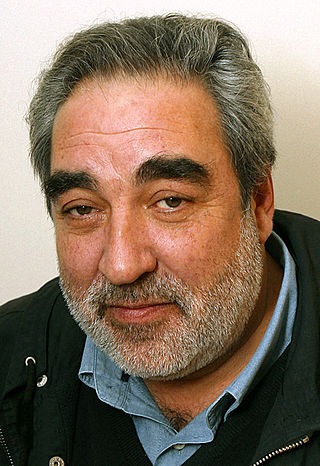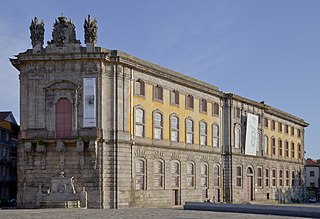
The Municipal Stadium of Braga is an all-seater football stadium located in Braga, Portugal, and the current home of Sporting Clube de Braga. It has a capacity of 30,286 spectators, making it the seventh largest football stadium in Portugal. The stadium was designed by Portuguese architect Eduardo Souto de Moura who was awarded the Pritzker Architecture Prize in part for this design.

Álvaro Joaquim de Melo Siza Vieira is a Portuguese architect, and architectural educator. He is internationally known as Álvaro Siza and in Portugal as Siza Vieira.

The University of Aveiro is a public university, in addition to providing polytechnic education, located in the Portuguese city of Aveiro. Founded in 1973, it has a student population of approximately 12,500, distributed among 58 graduate, 40 Masters of Science and 25 PhD programs, distributed by departments and autonomous sections, with specialized faculties. It is a Research & Development university, with research departments developing programmes in fundamental and applied mathematics, physics, chemistry, telecommunications, robotics, bioinformatics, sea sciences, materials, design, business administration and industrial engineering.

The Technical University of Lisbon was a Portuguese public university. It was created in 1930 in Lisbon, as a confederation of preexisting schools, and comprised the faculties and institutes of veterinary medicine; agricultural sciences; economics and business administration; engineering, social and political sciences; architecture; and human kinetics.

Trindade is a station on the Porto Metro system in Porto, Portugal and a former passenger rail station on the Linha do Porto à Póvoa e Famalicão and Linha de Guimarães of the Comboios de Portugal rail company.

Serralves is a cultural institution located in Porto, Portugal. It includes a contemporary art museum, a park, and a villa, with each one of these being an example of contemporary architecture, Modernism, and Art Deco architecture. The museum, designed by Álvaro Siza Vieira, is now the second most visited museum in Portugal.

Portuguese architecture refers to both the architecture of Portugal's modern-day territory in Continental Portugal, the Azores and Madeira, as well as the architectural heritage/patrimony of Portuguese architects and styles throughout the world, particularly in countries formerly part of the Portuguese Empire.

The Chandigarh College of Architecture (CCA) is a college imparting education and research in the field of architecture. It covers the north-western region of India including the states of Punjab, Haryana, and Himachal Pradesh as well as the Union Territories of Chandigarh and Jammu and Kashmir. The college has an enrolment of 200 undergraduates.

Eduardo Elísio Machado Souto de Moura, better known as Eduardo Souto de Moura, is a Portuguese architect who was the recipient of the Pritzker Architecture Prize in 2011 and the Wolf Prize in Arts in 2013. Along with Fernando Távora and Álvaro Siza, he is one of the alumni of the Porto School of Architecture, where he was appointed a Professor.
Fernando Luís Cardoso de Meneses de Tavares e Távora, ComSE, simply known as Fernando Távora, was a renowned Portuguese architect and professor.

Cecil Balmond OBE is a British Sri Lankan designer, artist, and writer. In 1968, Balmond joined Ove Arup & Partners, leading him to become deputy chairman. In 2000, he founded design and research group, the AGU . He currently holds the Paul Philippe Cret Chair at PennDesign as Professor of Architecture where he is also the founding director of the Non Linear Systems Organization, a material and structural research unit. He has also been Kenzo Tange Visiting Design Critic at Harvard Graduate School of Architecture (2000), Eero Saarinen Visiting Professor at Yale University School of Architecture (1997-2002) and visiting fellow at London School of Economics Urban Cities Programme (2002-2004).
The Lusíada University - North is a Portuguese private university located in Porto and founded in 1991.
The Faculty of Architecture and Arts at the Lusíada University of Porto is a private institution that offers undergraduate and postgraduate studies in architecture and design. Located in Porto, Portugal, FAAULP belongs to the Lusíada University of Porto.
The University of Porto is a Portuguese public research university located in Porto, and founded on 22 March 1911. It is the second largest Portuguese university by number of enrolled students, after the University of Lisbon, and has one of the most noted research outputs in Portugal.

Martha Thorne is an American architectural academic, curator, editor, and author. She is the Executive Director of the Pritzker Architecture Prize and Dean in the architecture school at IE University in Madrid. Formerly, she was a curator in architecture at the Art Institute of Chicago.

The Portuguese Centre of Photography was founded in 1997. The first exhibitions began in December of the same year on the ground floor of the building until 2000. The building was temporarily closed for renovation and reopened in 2001.

Casa da Música is a station of the Porto Metro. The architect of the station is Eduardo Souto de Moura. It is located in Boavista between Carolina Michaëlis and Francos and named after Casa da Música, located nearby. The station serves Lines A, B, C, E and F. It has two side platforms.

The Porto School is a movement of modern and contemporary architecture in Portugal. Grounded in the teaching at the Porto School of Fine Arts and the Porto School of Architecture, it is one of the most influential architectural movements in the history of Portuguese architecture. Its main figures, Fernando Távora, Álvaro Siza Vieira, and Eduardo Souto de Moura are some of the most globally renowned Portuguese architects.















